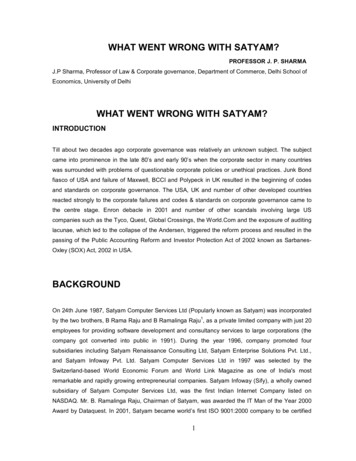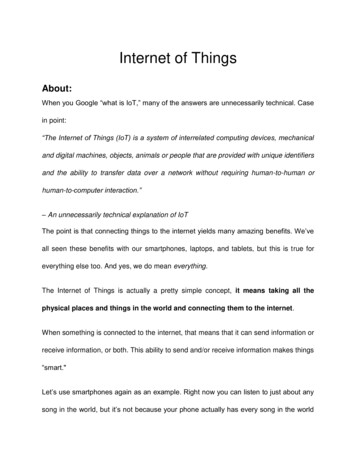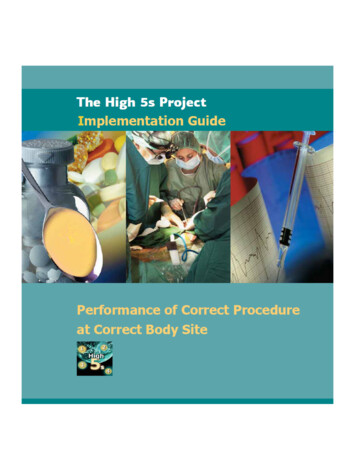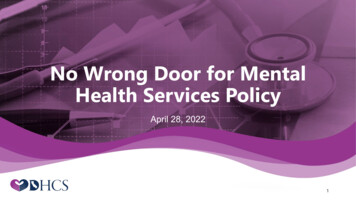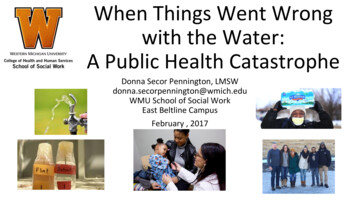
Transcription
When Things Went Wrongwith the Water:A Public Health CatastropheDonna Secor Pennington, LMSWdonna.secorpennington@wmich.eduWMU School of Social WorkEast Beltline CampusFebruary , 2017
Michigan’s EpicPublic Health Catastrophe Massive scale: city water supply Serious impact Time frame: Not days, but months, and now years Manmade Politically Charged/Protests/Extensive MediaThe early response was completely chaotic& disgracefully inadequate
The PrologueIn April 2014, the postindustrial city of Flint, with a population of100,000 people, under Emergency Management, changed its watersupply from Detroit-supplied Lake Huron water to the Flint River as acost-saving measure, while awaiting a new pipeline to Lake Huron in2016.Shortly after the switch to the Flint River water residents voicedconcerns regarding water color, taste and odor, and various healthcomplaints, including skin rashes.
“Hard to llow-toxic-water-toxic-systemflintACLU of Michigan Mini-DocumentaryKate Levy & Curt GuyetteJune 25, 2015
Race & Environmental Injustice:United Church of Christ & American Bar AssociationFlint residents who are majority black and among the most impoverished of anymetropolitan area in the United States, did not enjoy the same protection fromenvironmental and health hazards provided to other communities.Governor Snyder’s Flint Water Advisory Task Force Report (March 23, 2016)
A Public Health Catastrophe:Michigan Civil Rights Commission The Flint drinking water crisis has its root causes in historicaland systemic racism “A complete failure of government" Recommendations include a rewrite of the state'semergency manager law and bias training for state officials.“Flint residents have been subjected to unprecedented harm andhardship, much of it caused by structural and systemic discriminationand racism that have corroded your city, your institutions, and yourwater pipes, for generations."
The Toxic Flint Drinking Water August & Sept. 2014: Fecal Coliform Boil Advisories Oct. 2014: GM stops using Flint Water (corroding parts) Jan. 2015: State supplies water coolers & bottled waterto state employees in Flint (including MCRC) Jan. 2015 – Sept. 2015: Disinfectant byproducts TTHM Feb - April 2015: High Lead Levels detected EPA firstcontacted. Lee Ann Walters 13200 ppb (toxic waste)
Flint’s Toxic Water: 100 a Day
Timelines June 2015 Del Toral Memo Sept. 2015 Virginia Tech Water Study Sept, 24, 2015 Dr. Mona Hanna-Attisha news conference Oct. 1, 2015 State supports testing results Oct. 16, 2015 Switch back to the Detroit Water Dec. 14, 2015 Dr. Weaver: Flint State of Emergency Jan. 5, 2016 Michigan State of Emergency Jan. 16, 2016 Federal State of Emergency
Virginia Tech StudyWater Lead Levels in FlintSeptember, 2015WLL Standards: 5 ppb is concern, 15 ppb actionable WLL tests reflect only the levels on the day of the test Results: 19 times more corrosive than Detroit water Samples: average of 158 ppb, 20% of household 15 ppb Why Virginia Tech?
Institutional Ethics: Role of our Universities?The University began testing its water supply in the fall of 2014 in response to the “boil water advisories.” They found elevatedlead levels in Jan and Feb 2015 and removed sinks & water fountains and installed filters. This Fact Sheet was not publisheduntil 1/2016. The University protected its campus water supply. They reportedly called the Flint Water Department. What elsedid they do to protect/communicate with the community?
Institutional Ethics: Role of the Universities?Kettering began testing their water “because of growing concerns” in early 2015 and foud thecampus water was safe. First communication with parents, students and community was apparently9.16.15. What did they do regarding safety of their off-campus students & of the community?
Research: Impact of High Blood Lead Levels (BLLs)Lead in water is not what medicine/public health is “used to.”Much of the research is on paint chipsGreatest risk to 0-5 year olds (estimated 9,000 children,pregnant & nursing mothersDisproportionately impacts vulnerable formula-fed infantsLittle research on adults and elderly: hypertension, renalfailure, cognition
Elevated Blood Lead Levels BLLs increased from 2.4 to 4.9, in some neighborhoods to 6.6 inothers (Hanna-Attisha, et. al.) For children ages 1-5 years, for every 1 ppb increase in the waterlead level, blood lead increases by 35%.“Like the children were drinking through a lead-painted straw” Widespread testing in schools and clinics not necessarily useful.BLLs had likely peaked well before they were measured (30 daywindow)THESE RESULTS SIGNIFICANTLY UNDERESTIMATE EXPOSURE
Elevated Blood Lead LevelsIncreased likelihood of: ADHD Behaviors Restless, Inattentive, Impulsive (Kids in Street) Behavioral, Learning and Memory Difficulties Speech Impairment and Hearing Loss Delinquent behaviors and arrests Other possible health effects: Hematologic, cardiovascular,immunologic, etc.
Elevated Blood Lead LevelsImpact on Cognition Vast evidence supports likelihood of: An increase in 1 to 4 ug/gl means an IQ loss of 3-7 pts. Not a very significant change for any individual child, butbigger implications for the larger community A small change in mean IQ, shifts entire population IQdistribution Reduces high achievers ( 130) and increases numbersof kids with low IQ’s ( 70) Flint Schools test scores?
Ethics: Exposing the CrisisThe people of Flint were betrayed by every single governmentalagency that was supposed to protect them.“I believed them. I gave the water to my children to drinkand I bathed them in it.”When MPR contacted MDEQ for comment after initial reports of leadin the water, the Governor’s spokesperson, Brad Wurfel stated,"Let me start here — anyone who is concerned about lead inthe drinking water in Flint can just relax.“ (7-13-16)
Exposing the Crisis:Ethical Heroes of FlintMiguel Del ToralEPA Engineer6-24-15Dr. Karen WeaverClinical PsychologistMayor of Flint“I had to put some skin inthe game”Dr. Mona Hanna-AttishaPediatricianHurley Medical & MSU Faculty9-24-15“Pediatricians are the voice of the voiceless”Dr. Marc EdwardsEngineerVirginia Tech Professor
Dr, Marc Edwards
Crossing the Imaginary Line, Journal of Science & Technology
The State’s ResponseNo Words by Beverly Davidson, LMSW January 31, 2016“The city was eerily quiet, with a myriad of In and Out marts, gas stations,bars, vacant lots, run-down houses, and churches.I wondered where all the water trucks were, where the National Guardwere, where are all the governmental leaders?This city has its entire water distribution destroyed, and all we could seewere private volunteers at churches and businesses handing out cases ofbottled water to people through a make-shift assembly line.Where are the temporary water systems that our government could setup? Where are the military personnel and trucks who could deliver casesof water and filters to people who have no resources nor transportation?Folks are supposed to go to a local fire station, pick up a filter, a test kit,some water, and then return the test kit to the fire station fortesting? That’s the plan? Seriously? In 2016, that’s the plan?”
NASW-MI Ad Hoc Task Force/Crossing WaterJanuary, 2015 Tremendous gaps in the response Lack of information and awareness Access to clean water Marginalized populations: Elderly, disabled, undocumented, nonEnglish speaking, deaf community (Michigan School for the Deaf) Lack of transportation Socially isolated: mental health disorders The Many Problems with Filters Fitting, Changing cartridges: lights, size, cleaning aerators,Running hot water
The Chaotic Response Staff from EPA, U.S. Public Health Service, CDC, Genesee HealthDept., DHHS, MDE, Intermediate School District, National Guard,Nonprofits Two large crisis response groups:Community Resilience Group: Genesee Health Systems (CMH)Red Cross Community PartnersEducation Workgroup Genesee ISD Out of 12-13 working groups in the Crisis Response, none related tomeeting needs in the public schools
Humanitarian StandardsThe Sphere Project: International organization of humanitarianagencies, including Red Cross & Save the Children sets basicstandards. Average water for drinking, cooking and personal hygiene in anyhousehold is at least 15 litres or 495 ounces per person per day. Flinthouseholds received 1 case or 384 ounces per household per day. The maximum distance from any household to the nearest waterpoint is 500 metres or .31 miles. Flint had five water stations for acity of 100,000 with distances of 2-3 miles.
Response in Flint Water CrisisResidents pick up water daily in cars, on foot, bikes or buses.No systematic distribution of water to vulnerable d-40a9-aaf2c0fb7699a591What Life is Like in Flint, Michigan Three Years into the Water Crisis
Poisoned Water in the Schools In at least three Flint Community Schools,children drank lead-contaminated water for up to 16months. Lead levels were 15 ppbIn at least one school, Freeman Elementary, water testsfound lead levels of 101 ppb.Based on MDE data, 15,000 students & staff in 90 differentbuildings were exposed to lead in their water at homeand/or at school, only 5,000 in Flint SchoolsALL of the students experienced trauma
Genesee ISD as a Leader Hosted “Education” work group of the Red Cross Advocated for appropriate, accurate “parent friendly” information Discouraged school or community wide testing of children’s BloodLead Levels (BLL)(Provides false sense of safety) Some schools had “Blood testing carnivals” Urged a “universal approach” Assume all children may have been lead-exposed Provide universal interventionsSupplemental Fluoride Treatments
Systemic Racism & Implicit Bias “The people of Flint have everything they need.” Plans developed by state/county agencies with minimalinput from marginalized residents, grass roots/communitygroups Failure to meet humanitarian standards Failure to protect residents, especially children Need for door to door canvassing to assess needs: AAP, NAACP/NASW Recommendations
Community Resilience Group Mtg. 2/26/2016Concerns with the “partnership,” trust, cultural sensitivity.Why is there a dotted line for us and not an arrow?
In the Schools: September 28, 2015 Flint Community Schools send a letter to parents askingthem to bring water for their kids to drink during the day. Superintendent Bilal Tawwab said he knew he couldn't letthe kids drink from the fountains once he heard theadvisory.“My first reaction was, what are we going to do? I'mresponsible for over 5,000 kids here in Flint.” District asks parents to supply bottled water, but knows notevery parent can afford this and asks for water bottledonations. ?
Help for the Schools? By May, 2016, 9 school nurses were finally trained andplaced in the Flint Community Schools. Funding was increased for Head Start and Early On.Pre-existing participation was only 20% or less.
Racial & Cultural Barriers Pre-existing lack of trust Pre-existing stigma regarding mental health services &interventions, i.e., about just being “drugged up” Conspiracy theories & beliefs Need for culturally sensitive information, i.e., foods &nutrition
Public Health Information: Barriers NASW Task Force Greatest Injustice: Still households who didn’t know Need to provide accurate, understandable information at 5th gradereading level to protect health and restore trust Lack of access to information: Cable TV, News, NewspapersMuch internet based information:50% lacked internetUse of Radios stations?
InformationJust don’t let kids drink the bath water?Bathing: What about the skin rashes?vs.Steve Garvey Posting
Failure to Support Health Care ProvidersPsychological First Aid?
A Message from a Flint Health Care ProviderI am sorry for the delay in my response. In truth, since I am a Flint resident andworking in Flint Schools, I think I have been a bit befuddled myself about thesituation.One thing I think could be helpful is to have training re: the effects of lead, whatto look for in behavior. Some ideas about best practices in dealing with theseissues, possibly some resources to use with parents in helping to educate.We also could use some advocacy re: need for social work services in theschools. They are providing additional nursing services but nothing has been saidabout additional social work, and learning support services.
“Look for the helpers, you will always findpeople who are helping.”“We will need funding for medical homes, school nurses,school social workers, teachers and programs to provide asmany safe grown-ups as we can find to let these childrenknow that “it’s ok to feel scared, it’s ok to feel sad, and it’s okto be who you are because you did nothing wrong. And, I willtake care of you.” These children will need helpers in everydevelopmental stage of their life.”Beverly Davidson, LMSW
The Crisis ResponseSocial Work Heroes of the Flint Water CrisisMichael Hood & Laurie CarpenterCrossing WaterSenator Debbie StabenowWater Resources Development ActKenyetta DotsonGenesee Health SystemsWOWLibby NealisSSWAA/NEALobbyistAllan WachendorferNASWCrossing WaterBeverly DavidsonCrossing Water VolunteerBloggerElizabeth BurtchGeneseeHealth SystemsElla Greene-MotenMABSWBryanna McGarryPolicy Analyst MichiganSenate Democrats
American Academy of Pediatrics"Health and human rights are interrelated. When human rights arepromoted, health is promoted. Physicians have an important role toplay in promoting health and human rights, and addressing socialinequities." Ethics Manual, Sixth Edition.
Rapid Response Service Teams (RRSTs)A Flint Model Ideal: 3 members, a social worker, health care provider& one additional 4-6 hour shifts Assess/Meet needs /Restore of trust Two hour orientation for ALL volunteers Safety paramount: training in safety assessment for eachstop, never alone, calling in when changing location Teams visit pre-screened homes (referrals) Data sheet on each home before deployment Data sheet updated each visit, evolves to reflect needs Debriefing and food after each shift
RSST Tasks“We’re not from the government, we’re here to help” Provide “concrete” assistance: Deliver water, filters, hand sanitizer,baby wipes (waterless bathing), diapers, bus passes Provide and install faucet filters, replace expired filters. identifyhomes with incompatible faucets, other repairs Resource Binders: Information sheets on understanding the water &water testing, legal services, nutrition, food pantries, water accesssites, medical, water testing etc. Mental and physical health “assessments” Take new referrals LISTEN
Crossing Water: RSSTMemorable Experiences Living conditions: People living with no heat or water Isolated seniors, disabled individuals/couples with notransportation People with skin rashes of unknown origin People fearful of strangers & letting them into their homes. Visits that led to serious concerns about the welfare ofchildren or older adults Anxiety/fear of running out of water (“water hoarding”) Examples of Resilience!
Flint: February, 2017 Filtered water is declared by MDE/EPA as “safe to drink” Dissent of Genesee County Medical Society. Pregnant and nursing mothers and children under six yearsshould continue to use bottled water Residents continue to struggle with filters Talk of ending bottled water distribution (3 existing sites) Flint mayor is fighting to continue state water subsidies Installation of new pipes: 800 homes: more destabilization? RRST teams continue to find homes who have not accessedresources and residents who don’t understand the waterproblems Lack of school-based supports
Flint Three Years After Water CrisisCity Struggling to Move ing-to-move-on-880365123585
When will trust be restored? Many Flint residents remain afraid to drink tapwater, even with a filter. Fear of destabilization: new pipes, new pipelie Flint State Senator Jim Ananich
Maintaining HopeThis crisis could be seen as a unique opportunity toaddress systemic racism & be proactive, to improve theknowledge base for public health programsOver time, the cumulative impact of positive experiencesand coping skills can shift the fulcrum’s position, making iteasier to achieve positive ces/inbrief-resilience-series/
What can you do? Advocate & Educate! About the need for ongoing, increased services in Flint About the role of systemic racism and implicit bias: speak up! Volunteer: Crossing Water www.facebook.com/Crossingwater ingforflint Support legislation & policies addressing the Water Crisis, Pay dues to your professional associations! They pay for advocacyand lobbying efforts at the state and national level Contact: Donna Secor Penningtondonna.secorpennington@wmich.edu
References American Bar Association (2016, April 18). Flint Water Crisis: A Drop in the Bucket of the History between Flint and the EPA.Environmental Justice Committee Teleconference. Burke, Katie, (2016 May - June). Flint water crisis yields hard lessons in science and ethics, American Scientist. Davidson, Beverly (2016). No words, Look for the helpers and Racism Destruction of Democracy Flint’s Water Crisis,Blogposts, Voices from the Infant, Toddler and Family Field, Retrieved cism-destruction-of-democracy-flint-water-crisis/ Edwards, M., Pruden, Amy, Roy, S. Rhoads, W. (2016, October 10). Engineers shall hold paramount the safety, health andwelfare of the public — but not if it threatens our research funding?, Flint Water Study, Retrieved funding/ Goodnough, A. & Atkinson, S. (2016, April 30). A potent side effect to the Flint water crisis: Mental health problems, TheNew York Times, Retrieved from http://nyti.ms/1TloRxz Hanna-Attisha, LaChance, Sadler & Schnepp (2016). Elevated blood lead levels in children associated with the Flint drinkingwater crisis: A spatial analysis of risk and public health response, AJPH Research, 106 (2). Kuhlman, Mary (2016, April 18). Social workers continue boots-on-the-ground work in Flint,Public News Service, Retrievedfrom: ork-inflint/a51450-1 Mbacke, C. (2016 April 7). Michigan Association of Black Social Workers says crisis in Flint, Michigan is comparable togenocide, BlackNews.com, Retrieved from enocide/#.V cmfeArKhe NEA Healthy Futures (2016 May 18). Unlikely Partnership Provides Bottled Water to Students and Teachers in Flint,Learning First Alliance, Retrieved from: provides-bottled-water-studentsand-teachers-flint O’Connell, L. (2016, May 16). Protecting our Kids: The Long Term Impacts of Lead Poisoning, NASW-MI/Hurley Children’sCenter/U-M Flint Seminar, Powerpoint presentation
References Secor Pennington, D (January 2016) Meeting the Needs of Students in a Public Health Emergency, MichiganAssociation of School Social Workers, Retrieved from: oing-public-healthcrisis/ Email to: donna.secorpennington@wmich.edu or dsecorpenn@gmail.comMichigan Department of Civil Rights (2017, February 17). The Flint Water Crisis: Systemic Racism Through the Lens ofFlint, Report of the Michigan Civil Rights Commission, Retrieved from:http://www.michigan.gov/documents/mdcr/MDCR Flint Water Crisis Report 552190 7.pdf Sedlek, David, (2016 September 2). Crossing the imaginary line, Environmental Science & Technology, 50 (18), pp.9803-9804. Steele, William (rev. 2008). Trauma’s impact on learning and behavior: A case for interventions in school, Traumaand Loss: Research & Interventions, 2(2). NASW (1996). Code of Ethics, National Association of Social Workers, Washington, D.C. NASW-Michigan (2016) Flint Water Task Force Statement & Recommendations on the Flint Water Disaster. Flint Water Crisis: How NASW is Responding er-Crisis-HowNASW-is-responding.htm American Academy of Pediatricians: https://www.aap.org American Psychological Association: http://www.apa.org National Society of Professional Engineers: https://www.nspe.org/resources/ethics/code-ethics Detroit Free Press Editorial Board (2015 October 8). Flint water crisis: An obscene failure of 329846841.html NAACP (2016 March 16). Flint Water Crisis – NAACP 20-Point Community Priorities Plan. Retrieved ts/ Crossing Water: http://crossingwater.org/#home
VideosACLU: Hard to w-toxic-water-toxic-system-flintWhat Life is Like in Flint: 3 Years into the Water Crisishttps://www.youtube.com/watch?v tL6nBcsHgVMVT Professor’s Opening Statement re: Water Crisis in Flint, MIhttps://www.youtube.com/watch?v S5B1YKM0ndEDr. Mona Hanna-Attisha Press Conferencehttps://www.youtube.com/results?search query Hurley doctor recommends switching back to Flint riverCrossing Water: Deployments 8.27.16https://www.youtube.com/NBC News (2017 February 18) Three Years After Water Crisisin Flint, the CityStruggling to Move On. Retrieved from: g-to-moveon-880365123585
supply from Detroit-supplied Lake Huron water to the Flint River as a cost-saving measure, while awaiting a new pipeline to Lake Huron in 2016. Shortly after the switch to the Flint River water residents voiced concerns regarding water color, taste and odor, and various health complaints, including skin rashes.


